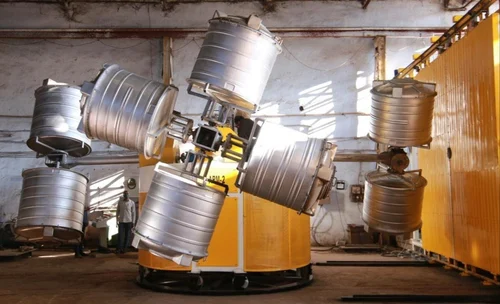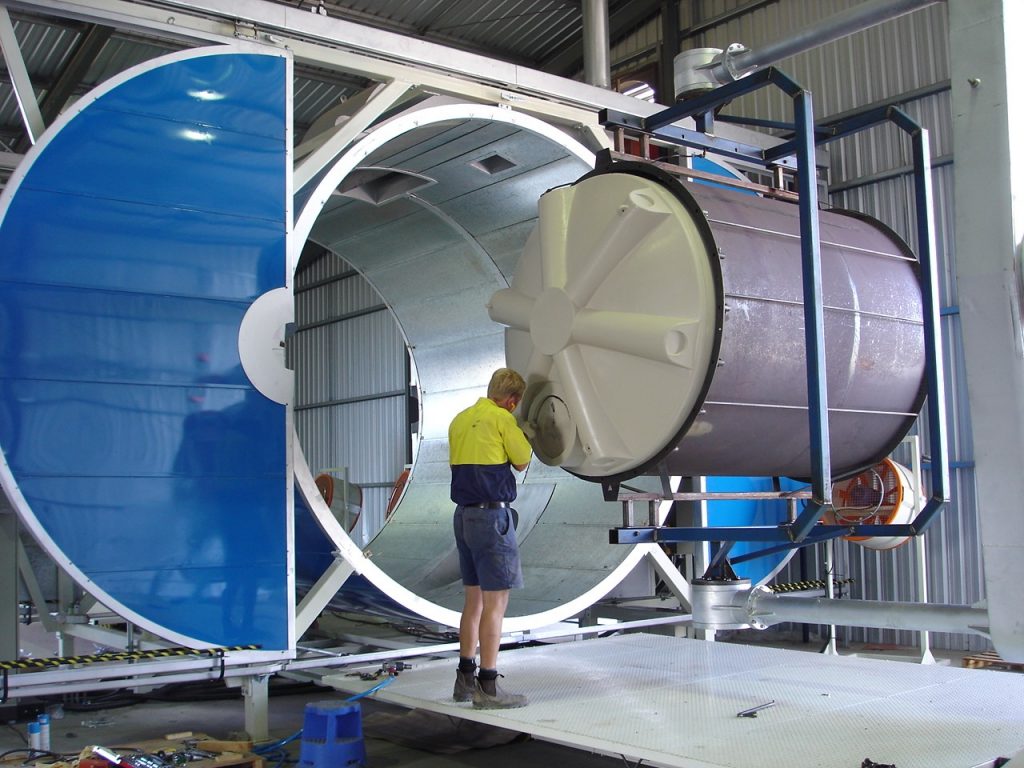
Rotational molding machines
Rotational molding (also known as rotomolding) is a versatile and cost-effective manufacturing process used to create hollow plastic parts. Choosing the right type of rotomolding machine depends on the product’s size, design, and application. In this article, we’ll break down the main types of rotomolding machines, key design tips, advantages, disadvantages, and common applications to help you make the best choice for your manufacturing needs.
Types of Rotational Molding Machines
1. Turret Machines
Turret rotomolding machines feature 3 to 6 rotating arms and resemble a carnival ride. Each mold gets equal exposure to heat, rotation, and cooling, making these machines ideal for high-volume production where uniform quality is essential.
2. Rock and Roll Machines
These machines get their name from the way they move—rocking and rotating. With a tilting oven and automatic cart movement, they’re best suited for large-sized products like water tanks and vessels.
3. Clamshell Machines
Clamshell machines have a single arm and an oven, with a lid that opens and closes like a clam. These compact and space-saving machines are perfect for low-volume production and smaller workshops.
4. Open-Flame Machines
These machines use rows of direct open flames to heat molds. They’re highly cost-effective for making cylindrical parts, such as barrels or drums.
5. Shuttle Machines
Shuttle machines have two carts and two stations that operate independently or simultaneously. This setup is ideal for high-capacity manufacturing and continuous production, offering greater flexibility and productivity.

Common Applications of Rotational Molding Machines
- Rotational molding is used across many industries to manufacture:
- Watercraft – kayaks, canoes, pontoons
- Storage containers – for water, chemicals, and bulk goods
- Children’s toys – tricycles, slides, playground equipment
- Trash bins and recycling containers
- Coolers – portable ice chests for food and beverages
- Industrial and agricultural tanks
- Carts and carriers
- Traffic and road barriers
Key Design Considerations for Rotational Molding Machines
To ensure high-quality rotomolded parts, product designers must keep these factors in mind:
▪ Draft Angles
Including a draft angle helps release the part from the mold easily during the demolding process.
▪ Wall Thickness
Wall thickness affects cooling time and structural integrity. For materials like polyethylene, ideal wall thickness ranges between 0.125 to 0.25 inches.
▪ Large Flat Surfaces
Flat areas may warp during cooling. Adding ribs, steps, or recesses can help avoid distortion and maintain shape.
▪ Corner Flow
Sharp corners can trap material and create uneven surfaces. Instead, use smooth curves and gentle radii for better flow and finish.
▪ Aesthetic Details
If visual appeal matters, you can incorporate surface textures or design features directly into the mold to improve the product’s final look.
Expert Insight:
“Rotomolding is a great alternative to blow molding for hollow parts like bottles and barrels.”
— Greg Paulsen, Director of Applications Engineering
Cost of Rotational Molding Machines vs. Other Methods
While the upfront cost of rotomolding equipment and tooling may seem high, it is significantly more affordable compared to other molding methods in the long run.
Case Study: 50-Gallon Trash Cans
| Method | Tooling Cost | Annual Maintenance |
|---|---|---|
| Rotational Molding | $20,000 | $1,000 |
| Blow Molding | $210,000 | $5,000 |
This makes rotomolding an excellent low-investment option for startups or manufacturers looking for a cost-effective production solution.
Advantages of Rotational Molding
- Uniform wall thickness and consistent part quality
- Low-pressure process allows use of aluminum molds
- Easy production of double-walled components
- No need for welding or joining—one-piece construction
- Fewer material defects and warping issues
- Minimal post-processing required
Disadvantages of Rotational Molding Machines
- Only compatible with thermally stable materials
- Machinery and tooling can be expensive, especially for custom molds
- Slower cycle times compared to injection or blow molding
Final Thoughts
Rotational molding is a powerful manufacturing method that offers design flexibility, durability, and cost-efficiency for a wide range of hollow plastic products. By choosing the right machine and following key design principles, you can create high-quality, long-lasting products that meet market demands while keeping production costs in check.
Need Help Choosing the Right Rotomolding Machine?
Whether you’re producing small-scale items or large industrial tanks, we can help guide you to the best equipment and design approach. Reach out to our team for expert advice and custom solutions.